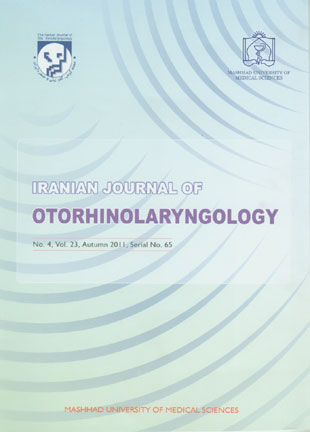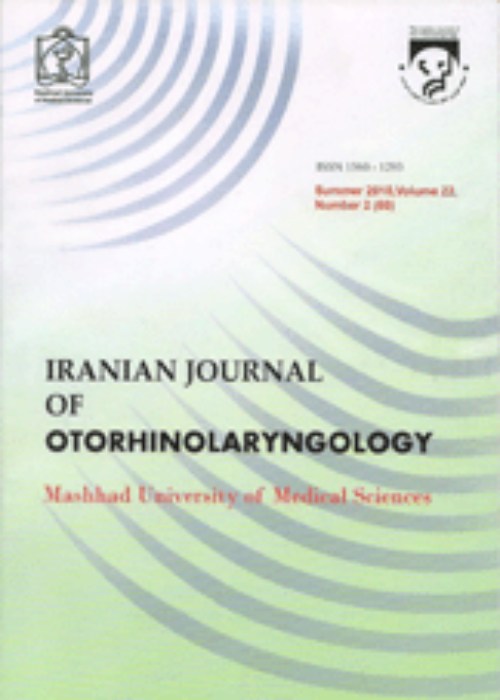فهرست مطالب

Iranian Journal of Otorhinolaryngology
Volume:23 Issue: 4, Autumn2011
- 64 صفحه،
- تاریخ انتشار: 1390/07/10
- تعداد عناوین: 8
-
-
Pages 111-118IntroductionThis study was conducted at the Department of ear, nose, throat, head and neck surgery, Post Graduate Medical Institute Lady Reading Hospital Peshawar. The duration of the study was one year from June 17, 2009 to June 16, 2010. The sample size was 82 patients with solitary thyroid nodule, fulfilling the inclusion criteria. After taking detailed history, thorough examination, relevant investigation and informed consent fine needle aspiration cytology was performed in all cases by the same cytopathologist. Thyroid surgery was performed and specimens were examined by the same histopathologist. The statistical analysis was performed using the statistical program for social sciences (SPSS version 11).Materials And MethodsOur study included 82 cases consisting on 57 female and 25 male, with female: male ratio of 2.28: 1.The age of the patients was ranged from 16-65 years with mean age of 42.56 + S.D 11.60 years. Most of the patients presented in 3rd and 4th decade followed by the 5th and 2nd decade. The diagnostic yield of Fine Needle Aspiration Cytology (FNAC) in this study was accuracy 82.92%, sensitivity 88.09%, specificity 77.50% and positive predictive value was 80.43%.Results126 patients entered the study among which 77 (61%) were female and 49 (39%) male. Mean age was obtained as 26.9 ± 7.7 yrs. Up to 79.4% of patients had complaints concerning the cosmetic outcomes, 39.7% with respiratory and 4.8% with olfactory problems. The reason to sue the physician had a significant relationship with the patients’ age and sex, and also with the surgeons’ experience.ConclusionFNAC has key rule in diagnosis of solitary thyroid nodule because it is safe, minimally invasive and cost effective diagnostic tool.
-
Pages 119-126IntroductionEsthetic surgeries are among the commonest medical procedures in the world nowadays; and as statistics declare, there has been a rapid increase in the rate of rhinoplasty during the recent years. Hence, as the number of cosmetic surgeries rises, the increment in the number of physicians being sued is quite inevitable; either due to complication in rhinoplasties or even inability to fulfill the patients’ expectations. This article aims to clarify the aspects of causes leading to these legal claims.Materials And MethodsWe designed a retrospective study according to the available files in the Iranian Organization for Forensic Medicine in which physicians were sued for the outcomes of rhinoplasty through the years 2004 to 2010. In addition, information on the patients’ demographic data, surgeons’ specialty and experience, and method of anesthesia were also collected.Results126 patients entered the study among which 77 (61%) were female and 49 (39%) male. Mean age was obtained as 26.9 ± 7.7yrs. Up to 79.4% of patients had complaints concerning the cosmetic outcomes, 39.7% with respiratory and 4.8% with olfactory problems. The reason to sue the physician had a significant relationship with the patients’ age and sex, and also with the surgeons’ experience.ConclusionThere are multiple reasons impelling the patients to sue surgeons after rhinoplasty, some are related to physicians’ malpractice and some to the patients’ social and personal circumstances.
-
Pages 127-132IntroductionOtosclerosis one of the most common causes of conductive hearing loss is more common in females and in their middle ages. It is usually a bilateral and progressive disease. Surgical operation is suggested as the exclusive management of otosclerosis. This study aims to evaluate the hearing results after stapedectomy in otosclerotic patients in Ahwaz.Materials And MethodsIn this retrospective and descriptive study, the records of otosclerotic patients who had undergone stapedectomy or stapedotomy in Imam Khomeini and Apadana Hospitals of Ahwaz, Iran during 1997-2007 were evaluated. All the operations were performed by a single surgeon (first author). Data were analyzed using SPSS and descriptive statistical tests.Results197 patients were included in this study. 66.8% were female and the age range was 20-40 years. The affected ears were reported as follows: right ear (65%), left ear (35%) and bilateral (18%). ABG was reported as less than 10db in 63.9% of patients; between 10 to 20db in 29.99% and more than 20db in 5%. Surgical complications were observed in 4.5% of patients (1.5% intraoperatively and 3% postoperatively).DiscussionSaccular dysfunction seems to be an important finding in SSNHL. Although it is more prevalent in the patients with vertigo, it can be found in the non-dizzy cases. VEMP disturbance in SSNHL shows more extensive pathological involvement.ConclusionJust like previously conducted studies, satisfactory surgical outcomes with rare complications were observed in the appropriate population under study.
-
Pages 133-139IntroductionInvestigators believe that anatomical abnormalities in the sinonasal region can be the cause of some chronic and refractory headaches that may respond well to surgical intervention. This study presents the prevalence of headache in patients with nasal septal deviation and their response to surgical treatment over a 2-year follow-up period.Materials And MethodsThis descriptive and prospective study was conducted on 98 patients with nasal septal deviation who underwent septoplasty surgery in the Imam Hospital in Ahwaz. Preoperative information was acquired by asking the patients and by completing SNOT-20 questionnaires by patients. After the surgery, information about changes in the quality of headache in patients with dominant contact points in preoperative nasal endoscopy whose headache responded to topical anaesthesia with lidocaine 2%+naphazoline 0.5% was collected over a 2-year follow-up. Final data were analyzed by SPSS and descriptive statistics.ResultsNinety-eight patients were studied, comprising 58.2% men and 41.8% women. They ranged in age between 18 and 46 years (mean=24). Nasal obstruction (72.4%), snoring (58.1%), headache (46%) and epistaxis (17.3%) were the most frequent preoperative symptoms. The most common site of the headache was the frontal region (68.8%). Patients'' headache was bilateral in 71.1% of cases. In 82.2% of patients, headache lasted less than four hours a day. The headache was pulsatile in 53.3%, sharp in 31.2% and compressive in 15.5% of cases. In the post-operative assessment, despite gradual decline in the referral patients for follow-up, a notable and gradual recovery in patients’ headache was seen with 82.8% of the patients reporting complete or partial recovery of the headache at the end of the 2-year follow-up.ConclusionHeadache is one of the most common symptoms in patients with nasal anatomical abnormalities such as septal deviation and usually responds well to surgical treatment. More studies with long-term follow-ups seems to be inevitable to determine the relationship between headaches and nasal anatomical abnormalities, accurate surgical results in patients’ recovery and the recurrence rate of headaches.
-
Pages 149-156IntroductionPseudoexfoliation syndrome (PXS) occurs due to the deposition of extracellular fibrillar materials on the anterior chamber of the eye. This syndrome has been considered to be part of a systemic disease with the potential involvement of the inner ear called sensoroneural hearing loss (SNHL). In this study, we aimed on evaluating SNHL within PXS patients in Iran to compare them with other international reports.Materials And MethodsIn total, 33 patients with PXS and 33 age and sex matched controls were enrolled prospectively in a case-control study. Both groups underwent complete ophthalmologic and otorhinolaryngologic examinations and pure tone audiometry (PTA) testing. Six frequencies (0.25, 0.5, 1, 2, 3, 4 and 6 KHz) were evaluated for PTA in the same ethnic group in order to select the case and control individuals. Data were analyzed using t-test and chi-square test.ResultsForty-nine out of 66 ears (75.2%) in the PXS group and 27 ears (40.9%) in the control group had SNHL (P<0.001). No significant difference was found between the existence of exfoliative glaucoma (EXG) and SNHL in the PXS patients (P=0.768).ConclusionOur results indicate a significant association between PXS and SNHL and may support the systemic nature of this disease.
-
Pages 157-160IntroductionCastleman''s disease is a rare lymphoproliferative disorder which may be confused with other causes of lymphadenopathy. Case Report: Here we report a case of unicentric Castleman''s disease presenting with cervical lymphadenopathy. The patient was treated with complete surgical excision of lesion and was disease free at the time of reporting this article. This case has been reported for its rarity.ConclusionThough castleman’s disease is a relatively rare entity it should be strongly considered in the differential diagnosis of cervical lymphadenopathy.


